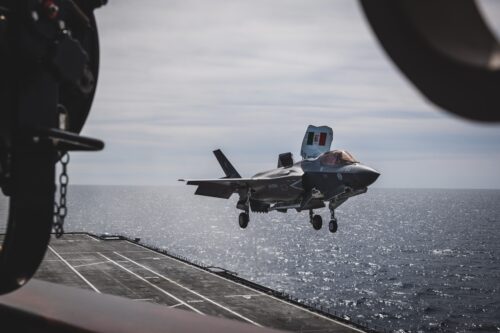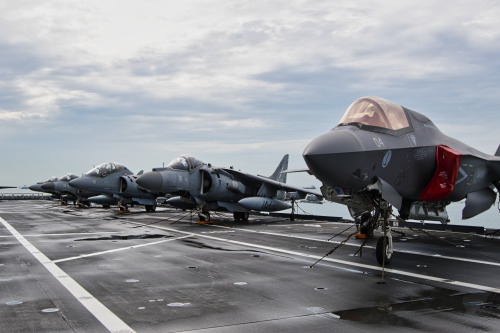On the overcast and humid flight deck of the Italian aircraft carrier ITS Cavour, during a port call at Changi Naval Base, Singapore, Captain Dario “ZAZA” Castelli, the Italian Navy’s Carrier Air Wing Commander, provided a comprehensive briefing on the Italian Navy’s transition from the AV-8B Harrier to the cutting-edge F-35B Lightning II.
A Decades-Long Journey
Captain Castelli, whose career spans from piloting AV-8Bs to overseeing the F-35B acquisition program, outlined the Italian Navy’s ambitious modernization efforts. “We’ve been operating AV-8Bs for more than 30 years,” he explained, “but in 2000, we joined the F-35 program, marking the beginning of a new era.”
The transition, however, was far from simple. It involved significant modifications to the Cavour, including strengthening the flight deck to withstand the F-35B’s powerful engines and installing advanced logistics systems. “It’s been a totally different story from the AV-8B,” Castelli noted. “With the F-35, there’s much more behind the aircraft.”
Dual-Platform Operations: A Unique Approach
One of the most intriguing aspects of Italy’s transition is its decision to maintain dual-platform operations. “We have seven pilots that fly both AV-8B and F-35B,” Castelli revealed. This unique approach allows for effective testing and comparison between the two aircraft types, ensuring a smooth transition while maintaining operational readiness.
The rationale behind this strategy is multifaceted. Firstly, it allows for a smoother transition period, maintaining operational readiness with the AV-8B fleet while gradually introducing F-35B capabilities. Secondly, it provides a unique opportunity for direct comparison and testing between the two aircraft types.
“The AV-8B is the first platform that we use against the F-35B to test it,” Castelli explained. “It’s our platform, we don’t have to call anybody to support us, we can do it every day. And we do fly the AV-8B with an F-35B qualified pilot that knows exactly what to do in order to test each other.”
This approach also addresses the challenge of pilot transition. By having senior AV-8B pilots dual-qualified on the F-35B, the Italian Navy ensures a transfer of experienced operational knowledge to the new platform. These seasoned aviators bring years of STOVL (Short Take-Off and Vertical Landing) experience to the F-35B program, enhancing the overall capability of the air wing.
Moreover, the upgraded AV-8B serves as an excellent stepping stone to the F-35B. Recent upgrades to the AV-8B fleet, including the addition of Link 16 and Mode 5 IFF, have brought some of its capabilities closer to those of fifth-generation fighters. This allows pilots to familiarize themselves with advanced systems and tactics before fully transitioning to the F-35B.
“Even if you’re a young pilot and you’re only flying AV-8B, you are an F-35B program pilot that can access brief and debrief,” Castelli noted. “So you will get to learn about F-35 while you’re still flying AV-8B. At that point, when you will be transitioning to F-35B, you will know everything about tactics and techniques.”
This innovative dual-platform strategy sets the Italian Navy apart from other F-35B operators and demonstrates a thoughtful, pragmatic approach to the challenges of transitioning to a new aircraft type while maintaining current operational capabilities.
Weapons Integration: A Critical Milestone
The briefing took an exciting turn as Castelli delved into recent weapons testing, a critical milestone in achieving Initial Operational Capability (IOC). “During Exercise Pitch Black, we were able to deploy air-to-ground weapons with the F-35B,” he said, his voice filled with pride. “We successfully employed the GBU-12, a laser-guided munition, demonstrating our ability to conduct precision strikes from the sea.”
But the achievements didn’t stop there. Castelli continued, “In Guam, we fired AIM-120 AMRAAM missiles with both the AV-8B and F-35B.” The AV-8B fired the AIM-120B version, while the F-35B employed the more advanced AIM-120C. “We used a drone that we brought from Italy as a target,” he added, highlighting the comprehensive nature of their testing program.
These live-fire exercises not only validated the F-35B’s combat capabilities but also showcased the Italian Navy’s ability to conduct complex, multi-platform operations. The successful integration of air-to-ground and air-to-air weapons systems marks a significant leap forward in the Italian Navy’s power projection capabilities.
F-35B as a Force Multiplier: Integration and Future Capabilities
Captain Castelli switched gears in his briefing as he discussed the F-35B’s performance during Exercise Pitch Black, a large-scale, multi-national air combat exercise that took place in Australia in July. The exercise provided a unique opportunity to test the F-35B’s ability to integrate with 4th generation fighters from various nations.
“One of the big points of Pitch Black was the fourth-fifth generation integration,” Castelli explained. “We were able to fly with F-15s, F-16s, F-18s, F-22s, and Sukhois. What we discovered was the fact that the F-35 becomes a battle manager and uses the fourth generation aircraft as shooters.”
This revelation highlights a significant shift in air combat tactics. The F-35B’s advanced sensors and data fusion capabilities allow it to act as an airborne command and control center, directing less stealthy but heavily armed 4th generation fighters to engage targets while remaining undetected itself.
“In many missions, we were also able to substitute ourselves into the command and control chain,” Castelli added. “The F-35 was actually exercising C2 during the mission.”
Looking to the future, Castelli outlined how Italy might leverage this capability: “In the future, we will do this with drones,” Castelli predicted. “You will have a drone with weapons, or what the U.K. calls the ‘loyal wingman’. I will take off with an F-35 and four drones that will be my wingmen, employing weapons for me.”
“If everything goes as planned, I won’t fight,” Castelli said, encapsulating the transformative nature of this approach. “The F-35 manages the fourth generation in flight, and that’s huge.”
This evolution in tactics and technology demonstrates how the F-35B is not just a replacement for the AV-8B, but a transformative asset that is reshaping Italian naval aviation and broader military strategy.
Future Aspirations
Looking ahead, Castelli outlined ambitious plans for the Italian carrier air wing. “We’re studying the integration of unmanned aerial vehicles for airborne early warning missions,” he said, mentioning the MQ-9 Bravo as a potential candidate. This move would address a current capability gap and significantly enhance the fleet’s situational awareness.
Additionally, with plans to acquire a total of 20 F-35Bs, the Italian Navy is poised to dramatically increase its sortie generation rate. “We might even be able to go 24 or more sorties per day,” Castelli projected, painting a picture of a highly capable and flexible naval air arm.
As the briefing concluded on the flight deck of the Cavour, the assembled journalists could see both AV-8Bs and F-35Bs parked side by side, a visual representation of the Italian Navy’s unique dual-platform approach. Captain Castelli’s briefing made it clear that the Italian Navy’s transition to the F-35B is more than just an upgrade in equipment; it represents a transformation in capabilities, doctrine, and Italy’s role in maritime security. With this innovative approach and leaders like Captain Castelli at the helm, the future of Italian naval aviation looks bright indeed.

